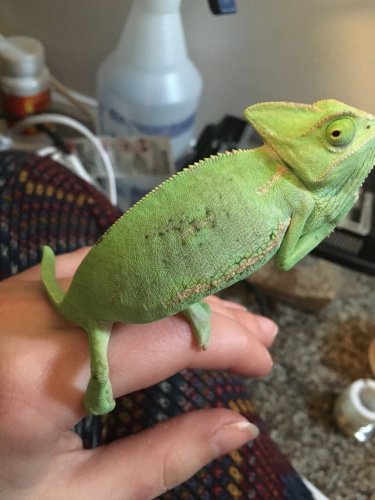Evsher
New Member
Chameleon Info:
Cage Info:
Current Problem - I just got back from a two night trip. My roommate took care of him while I was gone, however, I noticed that he is closing his eyes/blinking on occasion. I didn't notice him doing that before I left, so I'm a little concerned. He's still pretty active and is eating, but he seems to be drinking an awful lot so I'm beginning to think he may be dehydrated. Either way, I'd like a second opinion on what might be going on.
- Your Chameleon - Male veiled, unsure of age, but still young. I have owned him for two weeks now.
- Handling - Every other day
- Feeding - I have been feeding him around 3 crickets every morning and every night. I was gut loading with orange cubes and dusted them with calcium powder before feeding. As of today, I am beginning to feed him waxworms.
- Supplements - Reptivite calcium powder every day, flukers calcium with D3. I fed him the d3 the entire first week I owned him, unaware that it wasn't good for him. I now will be supplementing with D3 twice a month.
- Watering - I spray his foliage 3-4x a day, along with a water bowl. I have seen him drinking from the leaves. I haven't seen him drink from the bowl yet, but it is new.
- Fecal Description - Normal, brown poop with white urate.
- History - Unsure of his history, but I purchased him from Petsmart.
Cage Info:
- Cage Type - Screen 16x16x30
- Lighting - Zoo Med reptisun 5.0 UVB 13 w and daylight blue 60w. I have these both on from 10am-10pm
- Temperature - I have a temperature gauge in the corner of his cage, opposite of the basking light. This area reads to be 70 degrees. I have a space heater near his cage that is set to turn on when temperatures reach below 70.
- Humidity - The cage is generally around 75% humidity. I keep a humidifier placed against the edge of his cage, so he is able to climb onto the wall and sit in the mist if he'd like.
- Plants - I have two fake vines, a fake branch, and a small, live aloe vera plant.
- Placement - I have the cage on the ground in a corner of my room(two sides are open, two are against the wall). I have a space heater that turns on and blows air directly into the cage, but only turns on on occasion.
- Location - Michigan
Current Problem - I just got back from a two night trip. My roommate took care of him while I was gone, however, I noticed that he is closing his eyes/blinking on occasion. I didn't notice him doing that before I left, so I'm a little concerned. He's still pretty active and is eating, but he seems to be drinking an awful lot so I'm beginning to think he may be dehydrated. Either way, I'd like a second opinion on what might be going on.


